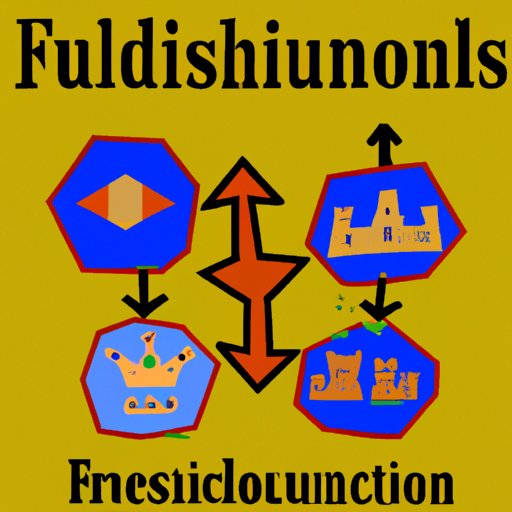Why Did Feudalism Develop?
Feudalism is a term used to describe a social and political system that existed in Europe during the Middle Ages. It is characterized by a hierarchical system of power in which lords, knights, and serfs played specific roles. This system dominated Europe for nearly a millennium, and although it began to decline during the Renaissance and Enlightenment periods, its influence can still be seen in today’s society. The purpose of this article is to explore why and how feudalism developed.
Origins of Feudalism
Feudalism originated in medieval Europe during a time when the political landscape was changing. The fall of the Roman Empire had left a power vacuum, and the decentralized Western Europe was left to fend for themselves. The feudal system developed as a way of protecting communities and providing stability.
Feudalism was a hierarchical system of power that was based on the relationship between the lord and his vassal. The lord was typically a king or noble who owned land and employed vassals (knights) to perform duties in exchange for protection and resources. Vassals, in turn, could grant land to other knights in return for their loyalty and assistance, creating a system of interdependent relationships. This structure provided a sense of security for those who participated in it, as the lord was responsible for protecting his subjects.
The growth of feudalism was influenced by several factors, including an increase in population, a need for protection, and the rise of new social classes. With the growth of population, people began to require more resources and protection. The lords, who owned most of the land, were able to provide this protection in exchange for loyalty and services from their vassals. This led to the development of knights, who were able to provide military assistance to the lords and, in exchange, were granted land and protection.
Economic Forces Behind Feudalism
The development and sustainability of feudalism were also influenced by economic forces. The feudal system was an agrarian society, meaning that the majority of people were involved in agriculture. The lords owned the land and the serfs lived and worked on it, providing labor in exchange for protection. This system allowed for the efficient production of food and other goods, and it sustained itself through the self-sustaining nature of agriculture.
The factors that contributed to the growth and spread of the feudal system included access to resources and technology. The lords owned the land and had access to the resources needed for agriculture and production. They also had access to technological advancements, such as the plow and horse collar, which made farming more efficient. The self-sufficient nature of feudalism allowed for it to spread throughout Europe as it provided stability and security to the people who participated in it.
Warfare and Military Power
Warfare was a significant factor in the development and spread of feudalism. The need for protection and stability led to the growth of military power and the emergence of knights. Feudalism allowed for the creation of a military class, which protected the lords and their land. The resources and prestige that came along with being a knight encouraged many people to join the feudal system.
Feudalism also impacted different regions in Europe in unique ways. For example, feudalism was more prevalent in Western Europe than it was in Eastern Europe. The reason for this is that Western Europe was more vulnerable to invaders and required a stronger system of protection. Feudalism provided this protection and allowed Western Europe to develop and prosper, while the Eastern Europeans relied on other forms of governance.
Comparing Feudalism to Tribal Societies and Monarchies
Feudalism was a unique system of governance that differed significantly from tribal societies and monarchies. Tribal societies were typically decentralized and relied on family and clan relationships, while monarchies were centralized and relied on the power and authority of a single leader.
Unlike tribal societies, feudalism was a structured system that involved a hierarchy of power and a strict code of behavior. Feudalism was also more hierarchical than monarchies, as it involved several levels of authority and power. This structure allowed for the efficient management of resources and the maintenance of social and political stability.
Religion and Feudalism
Religion played a role in shaping the power dynamics of medieval Europe. The Church was an influential institution that had significant power and influence over the feudal system. The Church played a significant role in legitimizing the power of the lords by providing religious justification for their authority.
The religious institutions also had an impact on the development of feudalism. The Church encouraged people to follow a structured code of behavior and morality, which aligned with the values of feudalism. The Church also provided support and protection to those who participated in the feudal system, as they were seen as upholding the values of Christianity.
Decline of Feudalism
The feudal system began to decline during the Renaissance and Enlightenment periods as more centralized forms of governance emerged. The rise of the nation-state and the growth of capitalism led to the decline of the feudal system. The commercialization of agriculture and the emergence of new technologies also contributed to the decline of feudalism.
The emergence of new political systems, such as democracy and capitalism, also played a significant role in the decline of feudalism. These systems provided new opportunities for people to gain power and influence, and they challenged the existing power structure of the feudal system.
Conclusion
In conclusion, feudalism developed as a way to provide stability and security during a time of political and social upheaval. The system was sustained by economic forces, warfare, and military power. Feudalism was a unique system of governance that differed significantly from tribal societies and monarchies and was shaped by the influence of religious institutions. While the feudal system declined during the Renaissance and Enlightenment periods, its influence can still be seen in modern society, particularly in the systems of governance and social organization that exist today.
